A tour through a fabulous Japanese department store food hall - Yokohama Takashimaya
One must-do in Japan for anyone interested even remotely interested in food is a visit to a depachika(see footnotes), or department store basement food hall. One of the more impressive food halls that I have seen is in the Yokohama branch of the Takashimaya department store. I recently had a chance to tour of the Yokohama Takashimaya food halls, with permission to take photos to my heart's content (something which is usually not allowed in department stores).
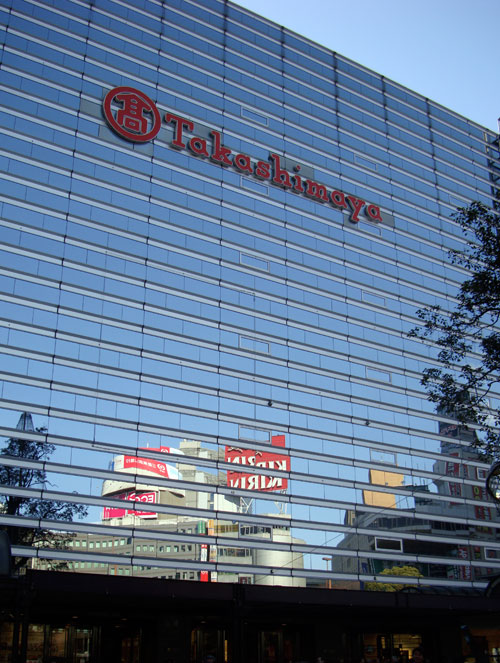
Takashiyama is one of the oldest and most respected high-end department stores in Japan. The Yokohama branch (link to English floor guide download page), while not the biggest in terms of floor space, is the one with the most foot traffic and the highest sales in the entire chain, and the food department is a definite highlight. There are several other department stores clustered around the huge, bustling Yokohama train station, but for some reason the Takashiyama food hall floors are always the most busy by far -- it always seems to be packed, especially in the afternoons and evenings. My mother, who is even pickier about the quality of her food than I am, swears by Takashimaya's food halls.
I'm a big fan of department store food halls, and try to go and visit them wherever I go. In my opinion, in terms of quality, Yokohama Takashimaya doesn't have to take a back seat to anyone, anywhere in the world.
Yokohama Takashimaya's food halls are spread out over two underground floors. The upper level (B1) is taken up by counters operated by various well known vendors of prepared foods, from pastries (both Japanese and Western) to tempura to bentos to pickles, tea and more, plus a dry goods department. The lower level (B2) is where the fresh produce, meat, fish and so on are sold. While the upper level has a lot to offer, it's the lower level that impresses me the most.
The first thing that catches your eye is the big vegetable display. All kinds of vegetables, both familiar and not so familiar to Western eyes, are sold here. Even in the middle of winter it's a sight to behold. I can vouch for how fresh the produce is -- their leafy greens for example are still in perfect shape a week after purchase and storing in the refrigerator. They have a mix of organic and regular produce, and everything is clearly marked by their place of origin (sometimes even down to the county or town.)
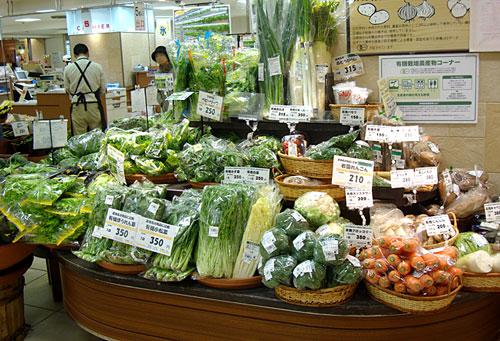
Gorgeous turnips and daikon radish, two quintessential winter vegetables:
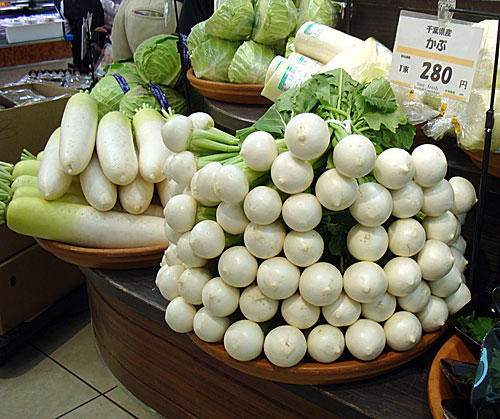
A beautiful cucumber display. (These cucumbers are quite tiny by Western standards by the way, about 8 inches / 22cm long at most and 3/4 inch / 1.75 cm or so in diameter).
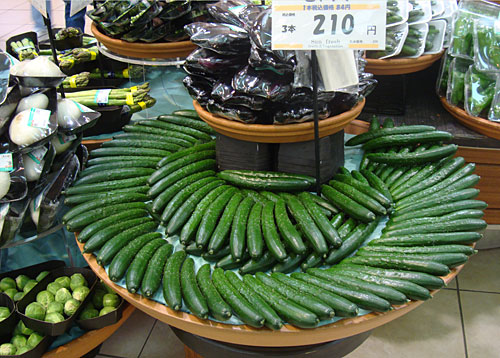
Their fruit is just as great. They were just starting to sell early strawberries (this was in early February) when I took these photos. You might think that strawberries in February would be hard and tasteless, but not these. They not only looked good, but tasted wonderful (there are lots of free samples on offer). Take a look at these monsters, a special kind of strawberry from Hakata on the southernmost main island of Kyush.! They too, tasted great, despite their huge size. (There is also a 'fruit parlor' where you can sample delicious, albeit rather expensive, sorbets and juices on the same floor, beyond the elevators.)
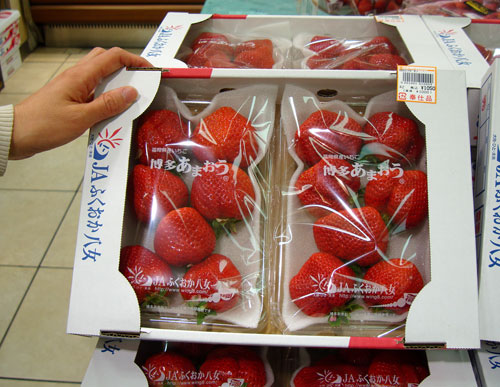
Then there's the absolutely fabulous meat counter, which is operated by a famous butcher and prepared foods store based in the Ningyocho area of Nihonbashi in Tokyo, Imahan (Japanese only web site). I never really thought of meat (not charcuterie like ham and so on, but just meat) as being beautiful to behold before...but their display cases say something else. Everything they sell is domestically produced. Here's some thinly cut wagyu beef with the most amazing marbling, for sukiyaki use:
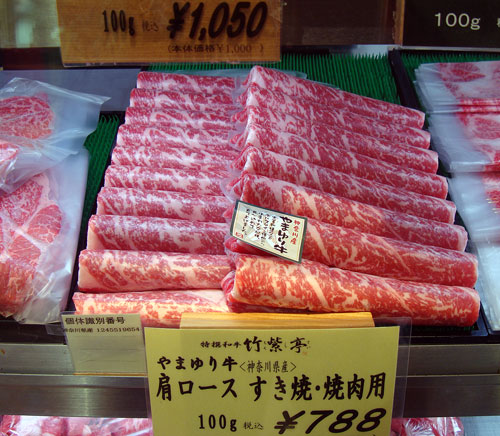
Here's some more wagyu, this time as steaks. Yes, they are rather mind-bogglingly expensive. (The price you see is yen per 100 grams, so a pound of the more expensive one on the left is around US $130 per pound...though that's about what Lobel's charges for American wagyu tenderloin steaks...):
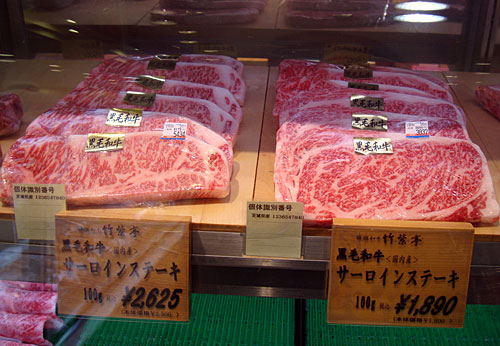
Even their ground meat looks great though. The upper level has pork, while the lower level has ground beef and and 'aibiki' (mixed pork and beef, a common combination in Japan):
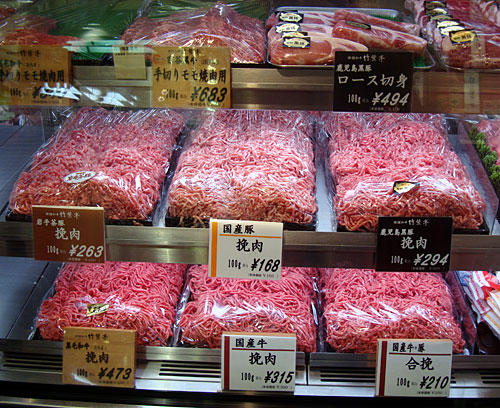
Here's a section of their chicken counter. The upper level has 'jidori' or free-range, organically grown chicken with the place of origin clearly marked. The lower level has all the bits - heart, kidneys, liver etc.
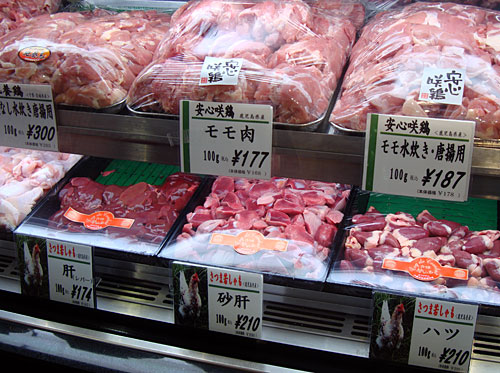
And of course, there are the fish counters...from fresh to dried and everything in between. Everything is of the highest quality, and quite a lot of it is caught locally (in the seas around Kanagawa prefecture, where Yokohama is located).
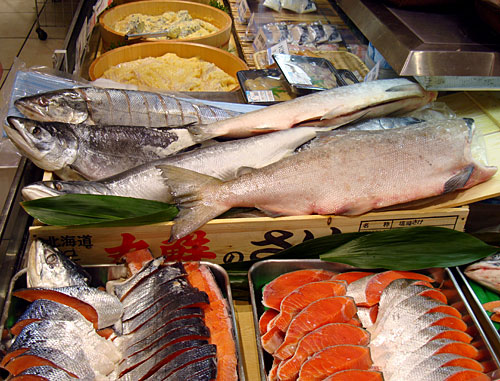
These are some himono (干物), or semi-dried fish. They are salted and sometimes flavored with something else, and dried for a short while. They are eaten simply grilled.
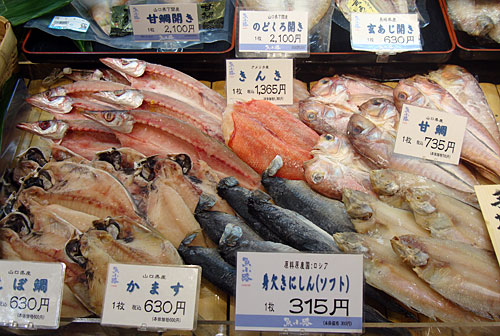
Sashimi, ready to go...just put out on a plate and eat! A popular choice for a quick dinner.
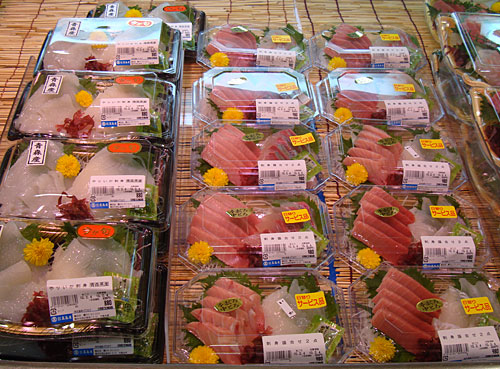
Prepping some asari (small clams).
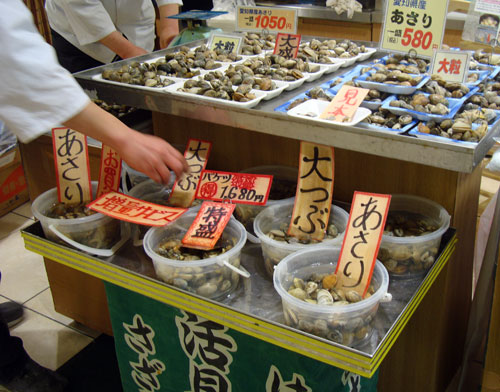
These are urume iwashi, semi-dried sardines. They are also eaten simply grilled.
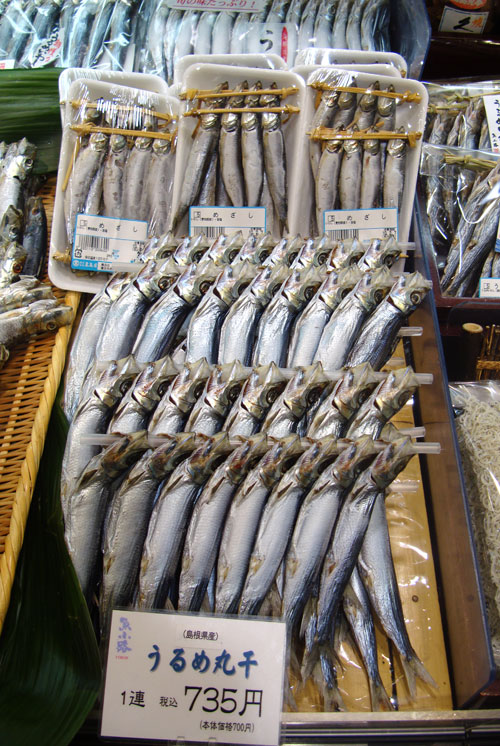
I only took a few photos of the upper floor, since it was already getting way too crowded by the time I got up there (around 11am on a weekday). This is the place to purchase prepared foods, both for consuming yourself or as gifts. You can also pick up some great bentos here for lunch or dinner in your hotel room, but you need to get there by 11am or after 3:30 or 4pm to grab one of the popular ones.
Just a selection of their soy sauces...you barely, if ever, see any of these brands outside of Japan.
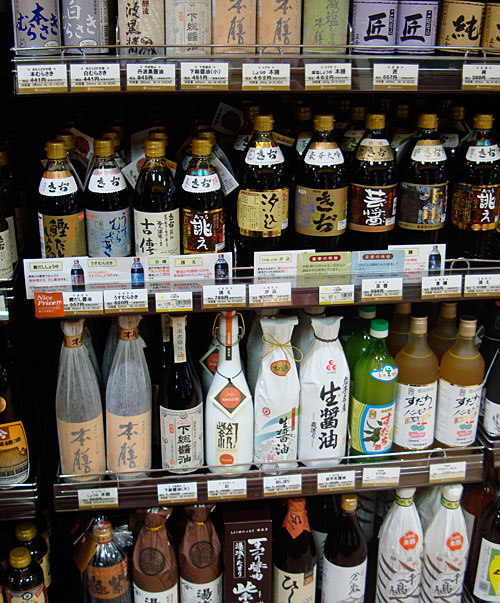
A shelf full of special-brand curry powders, roux and ready-to-eat cans. Again, all brands you don't really see in supermarkets.
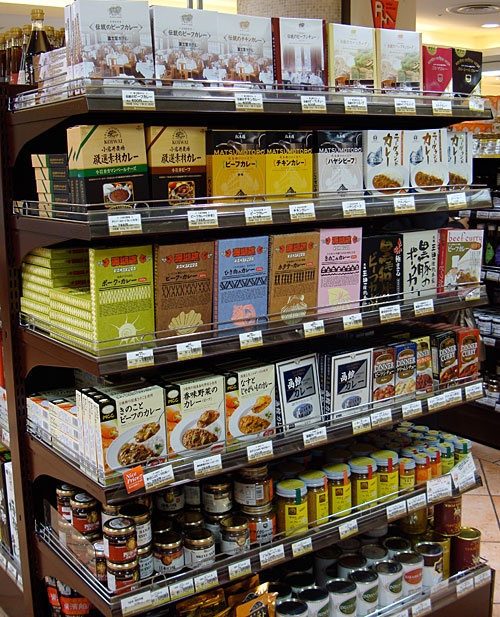
A peek at one of the several patisseries....
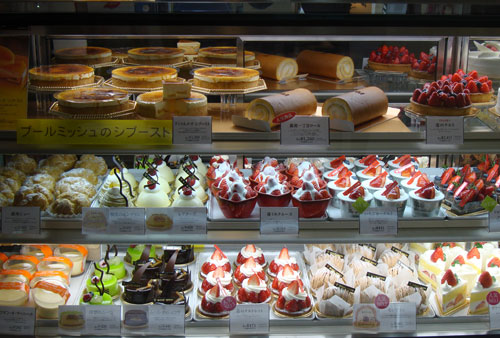
Some melon pan on display at a bakery counter (operated by a famous old-time bakery in Ginza).
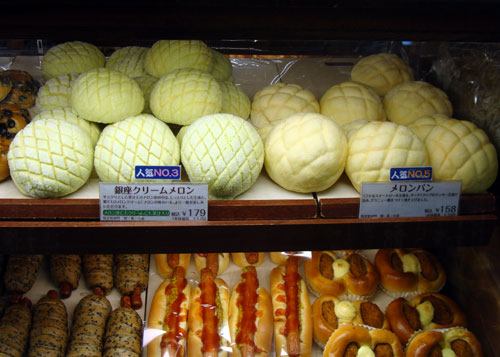
(Want more photos? You'll find them in my flickr stream.)
There seem to be several keys to the Yokohama Takashimaya food hall's success. First and foremost, each section of their food halls is operated by a real expert, not just any department store employee. For instance, as I mentioned above, the meat counters are under the care of an outside vendor who is renowned for their quality. The same goes for portions of their fish department too. The guys in charge of the fresh produce are also real greengrocers who know when something is in season and when it's not. (A couple of weeks after I took these photos, I went back there with my mother, who was after a certain type of satsuma orange or mikan. One of the greengrocers steered her to another type of mikan because he said the ones she wanted peaked earlier than usual this year, and that the lesser known type were at their real peak. The difference between the two in terms of high season was only about 2 weeks! But we could really taste the difference -- even though they were both priced the same.)
Another key is that, beyond knowledge, the service is absolutely great. From the speed and neatness at which the cheerful lady workers pack your groceries for you (with little ice packs, which are returnable and reusable) to their very reasonable same-day delivery service, they really have your back in so many ways. Here's Mr. Asano, who posed rather shyly behind one of the meat counters for me:
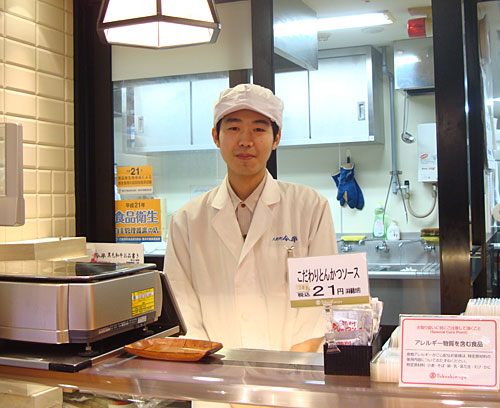
There's also the fact that the outside vendors that are invited in are under quite a lot of pressure to perform or else. If they don't have good sales, they are pushed out and replaced by another vendor. So the competition between vendors is quite fierce indeed, and their products simply have to be good to attract customers.
Finally, there's the fact that Yokohama station is one of the busiest in the country. Six train lines converge there, not to mention buses, so there's lots of foot traffic (Takashimaya can be accessed directly from the station via the basement level, and the main entrance it just steps away from the ground level train station exit). Still, as I mentioned already there are several other department stores with similar easy-access from the station, that are not nearly as busy. Sogo on the other side of the station for example is never really that busy -- even though they have quite a few of the same outside vendors that Takashimaya does! But then, their greengrocer for example is not nearly as good as Takashimaya's. And they certainly lose out in terms of the level of service.
In any case, it was certainly a very enlightening experience to be able to get a glimpse of the workings of a successful department store food hall.
One Hundred Flavors Festival (Aji Huyakusen) and other Takashiyama fun
Besides the food halls, Takashimaya also periodically has a food festival called Aji Hyakusen (100 Selected Flavors), usually on the 8th floor. Various vendors from all over the country are invited in to sell their stuff, and it's kind of a party atmosphere, with lots and lots of samples to try and little elderly ladies with sharp elbows and shopping bags poking you in the ribs or lower. (Incidentally I'm only 5 foot 3 or about 158cm tall but I'm still on the tallish side in Japan...) I have some pictures from the Aji Hyakusen held in February on flickr.
If you can manage to make it to any branch of Takashimaya before opening time (which is usually 10am), try to get to the main entrance with a good view of the glass doors. You may see the greeting ladies or girls, decked out in uniforms complete with hats, marching in rhythm and lining up in preparation for the opening. It's pretty amusing in a sort of fascist kind of way, if that makes any sense. Certainly something you don't see happen in American or European department stores!
I talked earlier about the great customer service Takashimaya offers. You'll find this on any of their floors. For example, the other day I had to get a small non-stick frying pan in their kitchen equipment department. I finally decided on the cheapest 3,000 yen model, and asked for assistance. The store assistant led me to the counter, asked me to take a seat there, fetched the pan from storage, gift-wrapped it for me, and otherwise made it a most pleasant experience -- for a cheap 3,000 yen frying pan!
Practical Notes on Yokohama
Yokohama Main Station (just called Yokohama, vs. Shin Yokohama, which is the Shinkansen station) is just about a 20-30 minute or so ride from Shibuya (depending on if you take a local, express or a special express train), on the Tokyu Toyoko line. Takashimaya can't be missed - there are big signs pointing to it, and it's right outside the West or Nishi entrance. There's also access from within the station.
If you make a trip to Yokohama, you should also visit Sogo, which is at the East or Higashi entrance. Even though I did rather dismiss their food halls, they do have a branch of a pretty amazing dry goods store there called Tomizawa Shoten. They sell about 20 kinds of white wheat flour (for bread and pastries) alone. It's sort of dizzying. Sogo also has a big branch of LoFT and a Muji (Mujirushi Ryohin) on the 7th floor. For bento and kitchen supply fans, there's also a large Tokyu Hands about a 5 minutes walk from Takashimaya.
If you have the energy, you can combine a trip to Takashimaya and so on with one to Yokohama's Chinatown, the oldest and most populated Chinatown (or so they say) in the world (outside of China, where they don't actually have Chinatowns, obviously). Yokohama's Chinatown or Chuukagai (中華街) is on the Minatomirai line, which connects directly to the aforementioned Tokyu Toyoko line.
Another place you can visit in Yokohama is the Shin Yokohama Raumen (Ramen) Museum (English site). This is near the Shin Yokohama station, which is a 10 minute ride on the Yokohama City Metro (Yokohama shiei-chikatetsu 横浜市営地下鉄)from Yokohama station. My report on that soon...
Other food halls
Most if not all department stores have food halls. One of the biggest and most impressive is the Tokyu Food Show, which is in the Tokyu Toyoko store in Shibuya station. Isetan in Shinjuku also has a very well regarded food hall.
Footnotes
- In other cities, I might recommend going to the open-air markets for serious food action, but in the Tokyo metropolitan area I think it's safe to say it's the better department store food halls where the action is. (There is the Tsukiji market, but that is basically for wholesale.) Department stores are where regular people shop for 'gourmet' stuff, and competition between stores is fierce, thus raising the overall quality.
- You may be familiar with the Takashimaya store on Fifth Avenue in New York; that store is really an anomaly since it's more of a specialized boutique than a department store. The Takashimayas in Japan are regular department stores, selling a wide variety of products.
- The term depachika (デパ地下), which is an abbreviation of the words depaato (デパート) or department store and chika (地下)actually has derogatory connotations, so people who work there and so on don't really use the term anymore, if they did at all. A depachika onna (デパ地下女)is slang for a woman (usually a bored housewife) who goes around tasting all the free samples on offer in a food hall, and never buys anything!
- My thanks to Ms. Yokota of the Public Relations department for showing me around and letting me take tons of pictures (as well as patiently answering my questions!) 本当にどうもありがとうございました!
If you enjoyed this article, please consider becoming my patron via Patreon. ^_^

 Welcome to Just Hungry, where we serve authentic Japanese recipes and more! I'm
Welcome to Just Hungry, where we serve authentic Japanese recipes and more! I'm 















Comments
Sasasunakku
23 February, 2010 - 15:10
Permalink
Re: A tour through a fabulous Japanese department store ...
Depachika, urayamashii! Despite the lovely cheeses and things we can get here in Austria, nothing compares to the Japanese attention to detail when it comes to food. I really miss it, thanks for a great post.
Loretta
23 February, 2010 - 15:43
Permalink
Re: A tour through a fabulous Japanese department store ...
A big thank you to Yokota San from me too - ありがとうございます!
I love the Takashimaya food halls (particularly as they stock my favourite Kamebishi soy sauce!) but it's so hard to convey their magnificence to people who have never visited Japan.
It's fantastic that permission was given to photograph some of the store's highlights. I look forward to using this article as an incentive to visit Takashimaya, it's a wonderful introduction and gives a marvellous insight as to why the food halls are so particularly splendid... even for Japan!
Oh those turnips! Even the turnip stems look delicious! (repressing a violent craving for nozawana now)
blacklilly
23 February, 2010 - 16:01
Permalink
Re: A tour through a fabulous Japanese department store ...
Hi Maki,
Thanks for the report on Takashimaya! I work about 5 minutes from there and sometimes am brave enough to wander into the food hall (those little old ladies are fearsome).
I was once taken by a very excited Japanese co-worker to the Japanese food festival on the 8th floor. It was full of local foods from all over Japan - even my favourite oyaki store from Nagano city was there. We had a great time sampling foods from all over, buying nice little treats (I bought dango) and trying not to lose each other in the crush.
Just one thing I spotted in your write up. Takashimaya is on the West side and Sogo on the East!
If anyone does go to Sogo, I highly recommend trying out the Mochi Cream shop. Small bites of heaven in many flavours!
maki
23 February, 2010 - 16:14
Permalink
Re: A tour through a fabulous Japanese department store ...
Oops I always get the Nishi and Higashi mixed up! Corrected now ^^;
Loretta
23 February, 2010 - 20:27
Permalink
Re: A tour through a fabulous Japanese department store ...
Is mochi cream still in business? Their store in Shinjuku had gone last time I was there and I wasn't able to locate another (I've never known the website to be active).
I do hope I haven't had my last taste.
blacklilly
25 February, 2010 - 06:27
Permalink
Re: A tour through a fabulous Japanese department store ...
There's now only one Mochi Cream shop in Yokohama, and I also found one in Machida. My first taste of one was in the JR station in Nagoya, though they generally tend to be in the basements of department stores. I'll keep my eye out for more!
Cheng
23 February, 2010 - 17:19
Permalink
Re: A tour through a fabulous Japanese department store ...
Hi Maki,
Nice to see those Amao strawberry from Hakata! They're being exported to Taiwan too. I've realized after seeing the price of vegetables from your photos that food price in Yokohama is apparently higher than Fukuoka. Or is it because they're sold in department store? I just bought a turnip (kabu) for 48 yen here. Anyway, thanks for taking so much photos. It's always interesting to see how foods are displayed in other cities.
maki
24 February, 2010 - 01:01
Permalink
Re: A tour through a fabulous Japanese department store ...
Takashimaya's prices are actually quite high...at a regular supermarket in Yokohama, the cucumbers for example are half the price or so. (and still pretty good quality I must say). Fukuoka is probably cheaper than Yokohama, since it's closer to the farms in Kyushu where a lot of winter produce comes from.
Hannah
23 February, 2010 - 19:23
Permalink
Re: A tour through a fabulous Japanese department store ...
I loved reading this, thank you! I fell in love with Japanese food on my first (and so far only) trip there a few years back, and loved exploring the department food halls. I may not have got to this one, but I loved the one under the Kyoto station.
Also, I got really excited spotting a Mont Blanc in your pastry photo - I LOVE those things! :D
Kevin
24 February, 2010 - 00:37
Permalink
Re: A tour through a fabulous Japanese department store ...
Maki,
thanks for the images! They really do look great.
Sort of an add-on to Cheng's question - how common are supermarkets in the 都心部? I'm currently staying in Minoh, Osaka, with three supermarkets in the vicinity (and a Carrefour around 3km away), but the two times I was in Tokyo (23 wards + Choufu + Kichijouji) the only things I saw resembling a supermarket were the fresh produce departments of the food halls. I might be moving to Tokyo come March, and seeing those prices in the pictures get me all jittery. I mean, I can get cucumbers here at 3 for 100 yen, so having to pay double for all my food is quite daunting.
maki
24 February, 2010 - 01:07
Permalink
Re: A tour through a fabulous Japanese department store ...
You might not find supermarkets in the center of town or so but you will find them in residential areas for sure. This is a question you can ask your fudousan-ya (estate agent) when you are inquiring about an apartment. They should know where the local shops are. Kichijoji for example, outside of the center, has plenty of supermarkets. Also, many of the private line stations (e.g. Tokyu, Keihin) have reasonably priced little supermarkets right in the train station which fulfill most daily shopping needs. On the other hand, the Tokyo area may be a bit more expensive than Osaka...I think they had cucumbers for 2 for 98 yen the last time I was at the local suupaa at the station near my mother's apartment ^_^;
Loretta
24 February, 2010 - 02:21
Permalink
Re: A tour through a fabulous Japanese department store ...
Even in the middle of some of the swankiest parts of Tokyo there are shops and supermarkets with more modestly priced food than at the department stores.
To reassure you, here's an example of somewhere I was buying my vegetables near Azabu Juban
http://maps.google.co.uk/maps?f=q&source=s_q&hl=en&geocode=&q=azabu+juba...
The trade off with this place was that the produce went off pretty quickly (within a couple of days) unlike the premium Takashimaya fruits & vegetables. So you should only buy what you will eat or cook with that same day. The shop had more foreign clients than Japanese perhaps for this reason. The food was very cheap though, and cucumbers were less than 33yen each. If you're committed to hunting out this kind of shop, you can live with very modest means in Tokyo.
Kevin
2 March, 2010 - 08:02
Permalink
Re: A tour through a fabulous Japanese department store ...
Thank you both for your help and advice! I remember seeing one such place at Asakusa, so I hope there'll be one near my place in Ikebukuro when I choose to move there.
Kristine
24 February, 2010 - 01:08
Permalink
Re: A tour through a fabulous Japanese department store ...
I love Japanese department stores, but the only thing that I can afford there is the food lol(and only certain foods too). I absolutely love the bakeries though.. they always have fresh, warm loaves of bread..mmm.. thanks for the great post!
alice c
24 February, 2010 - 01:45
Permalink
Re: A tour through a fabulous Japanese department store ...
Those strawberries look amazing :) My family usually gets Korean strawberries which are also big, juicy and sweet. I think in warmer climates though, the strawberry season start early -- in Taiwan you can usually start picking by February.
Another note on the cucumbers -- my mum who's from Taiwan loves using the tiny cucumbers. They have a great taste unrivaled by the big cucumbers you find in the west, and make kick-ass cold appetizer dishes! Apparently they are hard to find in Hong Kong, but abundant in Taiwan and Japan.
These pictures look amazing. Those Japanese supermarkets in Hong Kong that I go to a lot cannot even compare..
aa
24 February, 2010 - 05:28
Permalink
Re: A tour through a fabulous Japanese department store ...
One of the biggest and most impressive is the Tokyu Food Show, in the Ikebukuro branch of the Tokyu department store, also on the Tokyu Toyoko line.
I don't think there is a Tokyu in Ikebukuro - unless you mean Hands? I'd love to find it if there is a branch here, I'm in Tokyo for a couple of weeks and I'm staying nearby.
Most importantly I have to find some karukan - surely the finest wagashi of all?
Relieved to hear all is well with the family.
maki
24 February, 2010 - 06:55
Permalink
Re: A tour through a fabulous Japanese department store ...
I have no idea why I wrote Ikebukuro...I meant the Tokyu Toyoko store (in Shibuya station). I've corrected it now!
(And my family is very far from ok, which is probably why I'm making odd mistakes, but that's another story.)
Jas Min
24 February, 2010 - 09:10
Permalink
Re: A tour through a fabulous Japanese department store ...
Thank you very much Maki for giving us an insight into the more 'everyday/normal' aspects of Japan. If I had not read your article I might have never thought of visiting the food halls. Am definately putting this in my things to see in Japan list!
Sakura 21
24 February, 2010 - 14:43
Permalink
Re: A tour through a fabulous Japanese department store ...
I just recently found your blog and working my way through it. I have not been back to Japan in forever, and enjoyed seeing the photos of Takashimaya's basement. I really do miss the quality of the food found in Japan, which has no equal anywhere! I guess the flip side of that is the cost. I remember feeling like Urashima Taro (or Rip Van Winkle) when I went back for a visit after being in the US for six years. The cost of everything seemed so prohibitive. I can't even imagine what a reasonable obento lunch now costs. . . Highway robbery?
maki
24 February, 2010 - 15:34
Permalink
Expensive Japan?
Well, I feel like Urashima Taro (or Urashima Hanako!) in many ways in Japan, but is it that much more expensive...I don't know. Some things are, but I feel that for instance, eating out in the Tokyo metropolitan area is still pretty reasonable (ok the amounts are less) compared to say, the NYC area. Everyday eating out is much cheaper and of better quality I would say, especially when you consider that you don't have to worry about adding on tip and tax. High-end eating out in either place is rather prohibitively expensive of course. Groceries...well, when I compare the quality of produce, etc. at a typical Japanese supermarket vs. a typical supermarket on Long Island...it sort of makes me cry.
As for bentos...I have some featured in recent posts over on Just Bento :)
Sakura 21
10 March, 2010 - 18:02
Permalink
Re: Expensive Japan?
I just have to know. . . Do they still have Donku (ドンク )bakery in the department store basements? They had the best bread EVER, at least that's what I remember. They had fresh baked bread several times a day, and you had to time your visit just so or you could not even buy the particular one you wanted. Supermarket bread in the US just does not compare.
maki
11 March, 2010 - 15:58
Permalink
Re: Expensive Japan?
Yes there are lots of Donq stores all over the place. Though I'm not sure they are such a standout in my mind...there are many, many comparable bakeries.
YllsaDorf
25 February, 2010 - 06:05
Permalink
Re: A tour through a fabulous Japanese department store ...
Soooooooooooooooooooooooo jeaaaaaaaaaalooooooooussss
I wish I could visit Japan...I am getting better at understanding Japanese, but I am way too shy to speak it...everyone would laugh at me ;_;
I had the same problem in Costa Rica...I was very good at understanding and writing Spanish, but I was so shy when it was time to talk. I ended up writing a letter to my host family, and they laughed so hard when they read it in front of me because I explained that I knew what they were saying but I was, of course, too shy to respond.
We don't respect food in America. It's about what can I get how fast and cheap can I get it. It's too depressing to think about.
ginger
25 February, 2010 - 17:16
Permalink
Re: A tour through a fabulous Japanese department store ...
Love the pictures! What a great post!
Bethe
26 February, 2010 - 06:52
Permalink
Re: A tour through a fabulous Japanese department store ...
wow, everything looks so fresh and wonderful! Wish I were there to see it in person!
MN
26 February, 2010 - 11:16
Permalink
Re: A tour through a fabulous Japanese department store ...
I absolutely loved this post. My fav. part about Japan is the department stores. I was in Shinjuku last time I was in Japan but didn't visit Takashimaya's food hall (which I rather regret now, reading this!), but I did go to Isetan's, which is my absolute fav. Japanese department store of all time.
Since the Takashimaya in Shinjuku is attached to Tokyuu Hands, I only went there *once* because I can't resist anything in that place. They have bagel holders for individual bagels! *insane*
I also love Japanese department store bakeries, especially Daimaru (er... The one in Tokyo Station?) melon pan (which they call melon pan brioche or something) there I dream about. And don't get me started on swiss rolls. Once I discovered those, I had them for breakfast every day. -_-
Reading the other comments, I'm also sorry to hear about your family. I wish there was something I could say beyond light, well meaning words. I know how tough it can be, especially when you live in another country from your parents most of the time. :/
Susan
26 February, 2010 - 16:05
Permalink
Re: A tour through a fabulous Japanese department store ...
Thanks for the photos, really takes me back. And how I miss the food in Japan! I had almost forgotten about melon pan :/
Karin
1 March, 2010 - 17:17
Permalink
Re: A tour through a fabulous Japanese department store ...
I just stumbled upon your homepage and I'm SO excited to find it!
My mum is Japanese but I've lived all my life in Switzerland (where my dad comes from) and seeing all these Japanese goodies makes me want to go back...
Yuko
15 May, 2010 - 05:04
Permalink
Re: A tour through a fabulous Japanese department store ...
me too.. i will be back in Osaka after 1 year in California and just can not wait to eat all my favorites
TK
2 March, 2010 - 04:44
Permalink
Re: A tour through a fabulous Japanese department store ...
I love depachika.
But the best one in Tokyo is Shinjuku Isetan. So Im sure the best one in Japan is Shinjuku Isetan.
Gemma
12 March, 2010 - 14:15
Permalink
Re: A tour through a fabulous Japanese department store ...
This looks like an amazing place. I hope to see it one day for myself. Your pictures are amazing and I will come back here in the future to see what else you have to share. Thank you so much. Gamble here at this online casino and you will not be sorry, in fact, you will want to gamble casino en ligne bonus more often once you figure out what your favorite casino game is.
emmy
25 April, 2010 - 20:18
Permalink
Re: A tour through a fabulous Japanese department store ...
Hi there! I have been a long time fan of your website and never commented before. I am so glad that you posted the Yokohama Takashimaya store. I just got back from a three-month visit in Yamate where my parents live, and had the best time while there! It was so nice to be back where I grew up! My mother and I went to Takashimaya often since its our favorite store. One time we saw a white strawberry in the produce section selling for one for 1,500 yen and we could not help but laugh! But we are amazed every time we go there, especially the seafood section! And I miss Muji in Sogo, and the bookstore. And I always went to Qu'il Fait Bon for pastries. Have you been to Isezaki-cho? I went there often to get my used book fix at the Book-off, where I buy cookbooks! I went there a lot to eat Sanmamen too- which I prefer over Chinatown. I do enjoy Chinatown but avoid it at all costs during the weekends! Cheers and hope we can meet someday in Yokohama! Maybe in Moto-machi! :)
K-chan
28 April, 2010 - 14:57
Permalink
Re: A tour through a fabulous Japanese department store ...
I grew up in Yokohama, my mother is Japanese, and I have such wonderful memories of this Takashimaya. The monk that used to stand outside holding a begging bowl while chanting. The beautiful window displays at Christmas time.
None of my family live in Yokohama anymore so I never go there when I visit Japan. Perhaps I will take my children next time. Thanks for this wonderful post.
Apakoh
27 June, 2015 - 21:09
Permalink
Beautiful
Thanks for sharing!!!!! I can’t wait for my second trip to Japan, this time I’ll go the food areas of the department stores...those strawberries look amazing!!!